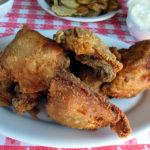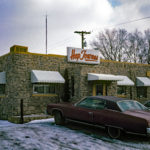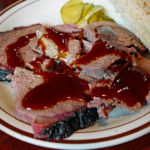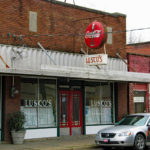Havana, North Dakota
As dawn's mist lifts away from the black earth west of the Bois de Sioux River and rows of sunflowers coil up to face the daybreak like soldiers coming to attention, a pot of coffee is put on to brew at the Farmers' Inn. It is the first of many pots to be made and poured that day in the town café, which is frequented by farmers and farmwives who live in and around the North Dakota village called Havana.
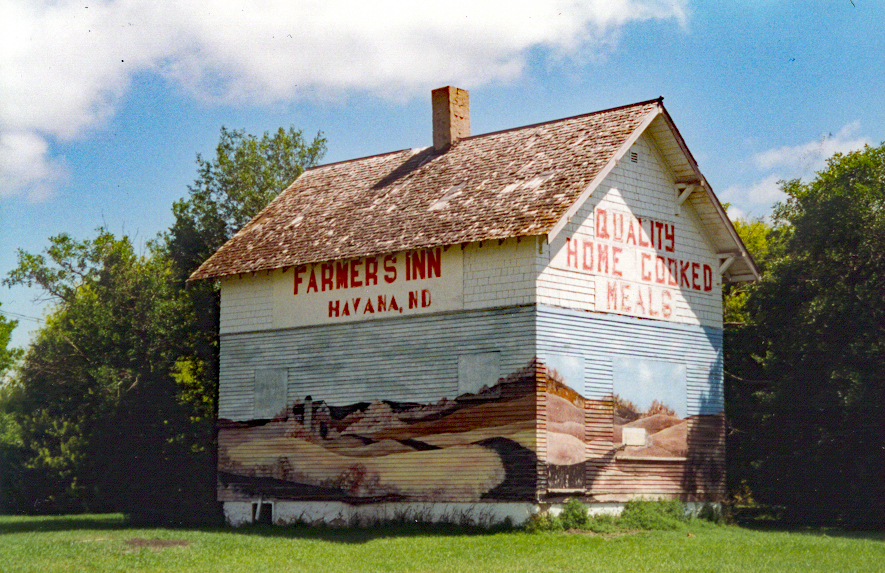
By Jane and Michael Stern
Originally Published 1997 Gourmet Magazine
As dawn’s mist lifts away from the black earth west of the Bois de Sioux River and rows of sunflowers coil up to face the daybreak like soldiers coming to attention, a pot of coffee is put on to brew at the Farmers’ Inn. It is the first of many pots to be made and poured that day in the town café, which is frequented by farmers and farmwives who live in and around the North Dakota village called Havana.
A most unusual enterprise, the Farmers’ Inn is the only restaurant for miles around—a valued gathering place for locals and a farm-food oasis for hungry travelers. Its heartland menu and small-town character are inextricably bound up with the life of the little enclave, for it is owned and operated communally by the townspeople. This is a place where neighbors can come to break bread together, where retired farmers hold court, young men eat five-thousand calorie breakfasts, and toddlers play with toys (a box of them is always on hand). Last Fourth of July, when the Inn was open only until 11 A.M., ninety-four meals were served—an amazing tally for a café in a dot-on-the-map town in the middle of nowhere with a population of one hundred, not including dogs, cats, and livestock.
Havana used to be bigger. When Slim Miller opened the Havana Café in 1913, there were 450 residents of the thriving grain-producing stop on the Great Northern rail line just one mile north of the Dakotas’ border. For decades his restaurant served as an ad hoc community club where people could come not only to eat breakfast and the midday meal (known as dinner) but to exchange tidings over coffee. Slim sold the place in 1948, after which several owners came and went. In the postwar years many farms switched from grain to row crops; agriculture modernized and small family farms grew more scarce. As time passed, Havana’s population thinned, business at the restaurant dwindled, and the old building began to crumble. Finally, in 1984, the Havana Café closed, leaving the town without a restaurant.
It was only then that citizens realized how much the place had meant to them. Jay Saunders, who runs the gas station, put a pot of coffee in his office for visitors to share. American Legionnaires opened up their hall as an informal gathering place. But neither of those well-meaning expressions of welcome provided the kind of easy, come-and-go atmosphere of a small-town café that is so conducive to a relaxed exchange of news and opinions.
Understanding that a restaurant in so remote a location had no chance of success if someone tried to operate it as a profit-making business, the members of the Havana Community Club decided to reopen the café on their own. Men pitched in and fixed up the old building; women volunteered to run the kitchen, agreeing to cook their specialties for neighbors and friends one day a month. The Havana school had just closed (children now travel to the bigger town of Forman for their education), so the refurbished eatery was able to get good equipment from the old school lunchroom. When the Farmers’ Inn opened a few days before Christmas in 1984, a comical sign on the bulletin board reflected the true soul of a meeting place in the midst of a sparsely peopled landscape: “Therapy Session 9-12 and 1-4. No Charge.”
Some days, more than forty people came for dinner. In the bitter North Dakota winter, when temperatures drop far below zero and farmers often finish chores early, tables were occupied for hours with pinochle players. And from 6 A.M. on, the coffee never stopped flowing. “If we charged fifty cents a cup, we’d be rich!” declared one volunteer cook last summer as she watched a gentleman in overalls help himself to what she estimated was his twelfth free refill of the day.
Once the citizens of Havana realized their cooperative effort was going to work, they determined that the old café building was hopelessly dilapidated. So they pooled their resources and built a new one, which opened in the winter of 1986. Farmers’ Inn II is a utilitarian steel structure with a spanking-clean, carpeted dining room where wood-grain Formica tables are outfitted with hand-hewn wooden napkin holders in the shape of cows, pigs, tractors, and horses—all cut and painted by a local retired elevator operator (that’s a grain elevator, by the way—the only structure around here more than two stories tall). A bulletin board includes a flyer for a polka band, and a manila folder tacked up with a note on it saying “Please Put Your Havana News in Folder.” Items deposited find their way into the “Havana News” column of the Sargent County Teller, which includes such stories as: “Joe Barbknecht arrived and joined his family at the Walt Barbknecht farm.”
Passersby are welcome at the Farmers’ Inn, but not many strangers find their way through the door. If you happen to be motoring along Route 32, which is straight as an arrow through land that is flat as a floor, it is actually quite shocking to encounter any kind of enterprise other than a farm. But here it is, a beguiling sight: a roadside house with a primitive sign that reads “FARMERS INN…HOME COOKED MEALS” and features an idyllic painted mural of the landscape. Turn off the highway at the house and soon you find the main street of Havana, two short blocks of buildings that face the train tracks and a dozen grain elevators. Other than the restaurant, the only businesses are a self-service gas station (residents have their own keys) and the combination general store and post office. Newcomers who drop in will likely be asked to sign the guest register—a visitor in these parts is cause for celebration.
Usually, there are waitresses: high-school girls in the summer, who get paid an honorarium of $10 dollars per day, plus tips. Still, it is common for regulars to help themselves to coffee from the pot and to walk up to the kitchen window and tell the cook on duty what they want.
“Two eggs, over,” announces one gentleman, clearly a regular. “Over hard…”
“I know, I know,” says Murdean Gulsvig, who shares kitchen duties this day with Doris, his wife of more than fifty years. ” ‘Throw ’em up against the wall, and if they bounce they’re hard enough,’ right?”
Murdean is a playful character who manages to tend the griddle with experienced savoir faire and keep up several conversations all at the same time. A septuagenarian retired farmer with a few tufts of red hair combed across his scalp and a Farmers’ Inn apron tied around his corn-fed girth, he is something more than just this day’s cook; he also serves as operations director for the café, ordering supplies and overseeing the planning of each month’s menu and daily cooking assignments. When he and Doris do draw kitchen duty, Murdean is known for the delicious coarse-ground breakfast sausage he makes, as well as for pancakes that are plate-wide and fluffy inside, with an ethereal lace-textured surface.
At 6:30 in the morning, when the dining room is getting crowded and the air swirls with the wake-up smells of brewing coffee and sizzling breakfast meats, Doris Gulsvig totes a pan of oven-hot caramel rolls out of the kitchen and sets them down to cool near the coffee station, then stops to write the dinner special on a blackboard. As is always the case, there is one prix-fixe hot meal—today’s is pork roast with dressing, gravy, mashed potatoes, corn, cole slaw, and lemon pie (for $4.50)—as well as a small assortment of soups, sandwiches, and hamburgers just in case the kitchen runs out of its main course.
Once the breakfast crowd clears out, Murdean and Doris spend the morning stirring the lemon filling for the pie, boiling potatoes, tasting the stuffing to see if it’s seasoned right, and watching the roast cook. “You better mash those potatoes now, or they’ll get too soft,” Doris calls to Murdean, who has managed to escape the kitchen to a dining room table where he visits with friends.
Murdean shrugs with good-natured resignation. “See how hard she makes me work?” he says, pretending to seek sympathy as he heads back through the swinging door. Doris holds the pot and pours in the hot milk while Murdean does the mashing. As he works, he boasts, “We got a ninety-nine when the health inspector came around. It would have been one hundred, but we won’t wear hairnets. Jiminy Christmas, I don’t have enough hair to put a net over!”
You can count on Doris and Murdean in the kitchen at least a couple days every week. Nowadays, instead of a different cook every day of the month, the rotation has been trimmed down to about half a dozen cooks taking turns. The cooks we met made a point of distinguishing their cooking—”farm cooking”—from restaurant cooking. The latter, they said, is more deluxe and uses ingredients they don’t find in the grocery store and, worse, that their husbands wouldn’t recognize. While not at all embarrassed to use canned soup for a casserole or cake mix for pineapple upside-down cake, they also know how to make slow-risen butter horn rolls and old-fashioned “knefla” soup with hand-rolled dumplings.
In the summer, they make use of garden tomatoes and cucumbers and, when Harlan Klefstad returns from his winter home in Arizona, there will be pies prepared from the lemons he brings back from his tree there. Mary Ann Fliehs is especially talented when it comes to pies—rhubarb, sour cream, lemon meringue, and coconut cream. Marie Underberg is delighted when the menu calls for roast turkey, because then she can bake her big pumpkin cake for dessert.
“This is what I call a gravy-and-potato café,” declares Harvey Peterson, whose wife, Gloria, is known for the raisin sauce she makes for ham. Mr. Peterson, who has farmed the land for more than fifty years, is a regular who, amazingly, drinks no coffee. One summer morning, at a table with his wife and some other cooks and his grandson, he spoke of the days long, long ago, when Havana had four flourishing grocery stores, two department stores, and a twenty-piece band for promenade concerts in the warmer months. He recalled how empty the town seemed when the Havana Café closed. “Now look at what we have,” he said with a measure of pride, gesturing to a dining room crowded with Havanans, including oldsters bragging to each other about grandkids’ school scholarships and baseball hitting averages; young families marshaling their members for a nearby tee-ball tournament; and working farmers engaged in an incredibly precise discussion about the spring wheat they raise versus white wheat, winter wheat, and soft red wheat.
“The Farmers’ Inn holds our community together,” Mr. Peterson concluded.
“It’s like going to church on Sunday,” one of the cooks added. “Except you don’t have to be Lutheran to have your coffee here.”
“Maybe we did save this cafe,” another added thoughtfully. “But the way I see it, this café saved us.”
Farmer’s Inn
Discuss
What do you think of Havana, North Dakota?
Related Articles
Stroud’s
By Jane and Michael Stern Originally Published 1995 Gourmet Magazine Chicken...
The Lobster Roll Honor Roll
Maine is the only state in America that features a picture of cooked food on its license...
Meat-And-Three
A few years back, country singer Ray Stevens invited a New York friend to join him at one of...
Top 12 favorite Ice Cream Scoops
WITH THE EXCEPTION of the hot dog bun, there has never been an edible invention as...
Top 5 BBQ Restaurants | Western Kentucky
Get yourself to Western Kentucky for great BBQ I see the food shows on TV where...
Best restaurants in Greenwood, MS | Hot Licks Delta Style
Ever since we first ate margarine-sauced pompano at Lusco’s, in Greenwood,...

